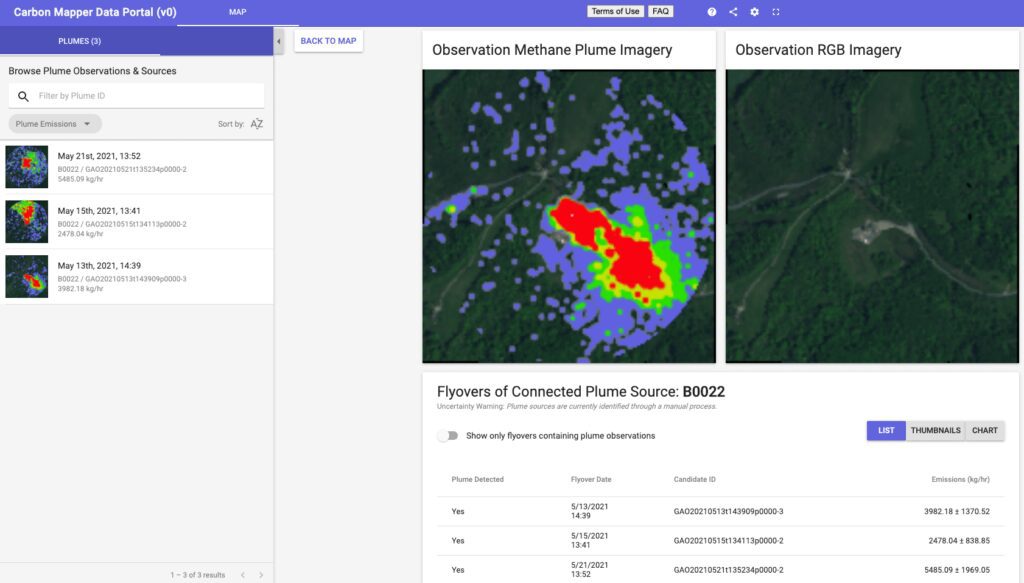Introduction:
This is our first Carbon Mapper Data Dispatch, a regular communication highlighting insights and information from Carbon Mapper Data Portal. We believe transparency is critical in the global fight against climate change. That’s why Carbon Mapper is committed to delivering accessible data on methane and CO2 emissions, so that it can be used by policymakers, regulators, operators, and civil society to guide science-based action to reduce emissions.
Data Highlight:
Plume ID: GAO20210521t135234p0000-2; lat: 39.96403869; long:-80.36320889
What You See:
This image shows methane emissions observed during multiple airborne surveys of a Pennsylvania coal mine vent in May 2021.

Why it Matters:
Methane emissions are commonly associated with oil and gas production. But coal venting is also a significant source of methane emissions, contributing about 9% of anthropogenic methane emissions in the U.S. and globally according to the Environmental Protection Agency (EPA). Carbon Mapper surveyed large sections of Pennsylvania in spring and summer 2021 to assess methane emissions from coal and natural gas production. We found that coal mine methane emissions in western Pennsylvania represent 60% of strong point source emissions across the areas surveyed.
The methane plume pictured here was detected repeatedly and was measured to be emitting as high as 5485 ± 1969 kg/hr on May 21, 2021. Our overflights detected persistent strong methane emissions from multiple vents from four large coal mines in southwest Pennsylvania that appear to be contributing 22% of reported total U.S. underground mine emissions while accounting for 5% of U.S. coal production according to the EPA. While our estimate of total observed methane emissions from these mines was in general agreement with numbers reported to the EPA’s greenhouse gas reporting program, we observed significant over- and under-reporting at the scale of individual facilities.
This highlights the importance of regular, direct emissions monitoring to understand the true methane footprint of individual facilities and to help inform opportunities to curb emissions. Coal mine venting is a permitted practice in the U.S. and is conducted primarily for safety reasons. However, unlike the oil and gas industry, coal mines in the U.S. are not required to flare vented gases. Flaring is designed to combust methane to convert it to carbon dioxide (CO2) before release to the atmosphere (EPA guidance for state and federal oil and gas venting and flaring regulations is available here).
While flaring generates CO2 which is also a powerful greenhouse gas, venting methane directly to the atmosphere is vastly more harmful to our climate given it has a far stronger global warming potential (nearly 90 times higher than CO2 over 20 years). However, there are multiple options for recovering and using coal mine methane as summarized here.
As policy makers look for immediate opportunities to curb methane emissions and meet domestic and international targets, such as the U.S. Methane Emissions Reduction Action Plan and the Global Methane Pledge, a renewed focus on recovering coal mine methane offers tremendous potential.
“Just because a practice is legal doesn’t mean it is right, and coal venting falls into the category of a practice that is wasteful and harmful to the environment,” said Riley Duren—Carbon Mapper CEO. “There are known solutions to capture and repurpose the methane released from coal production however current economic and regulatory incentives to adopt those solutions are still lacking.”
A pioneering methane capture project in Colorado is commonly cited as an example of the myriad of regulatory and economic hurdles that need to be overcome to capture waste methane and use it as energy. But successful case studies exist and a partnership with the local ski company, neighboring counties, utilities, the state, and others made the project possible and—according to recent reports from Aspen Skiing Company—profitable.
Regular monitoring of high-priority regions for methane from ALL emitting sectors including oil and gas, coal, waste, and agriculture is necessary to provide a complete and accurate picture of emissions and to highlight opportunities for accelerated emission reduction.
Subscribe:
Get Carbon Mapper data dispatches and updates from our data portal—such as notifications when new data sets are added, or system upgrades are made—by subscribing on our website.
